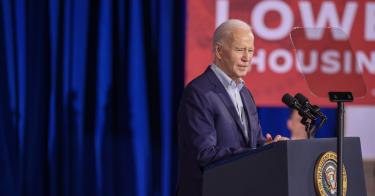President Joe Biden promised to lower housing costs during his State of the Union address earlier this spring. To date, his plan has been an utter failure.
Just ask Anthony and Caitlin Fumo. A recently married couple with a newborn baby boy, they assumed their combined income would be enough to finance a move closer to their parents. But thanks to Bidenomics, leaving their small rowhome in Philadelphia for a slightly bigger place in Jersey would mean paying almost $2,500 more per month for a new mortgage.
As Anthony recently told the Wall Street Journal,“It feels like we make too much money to still feel like we’re behind.”
Unfortunately, the latest inflation data from the Bureau of Labor Statistics shows that circumstances aren’t likely to improve for families like the Fumos any time soon.
In roughly three years, the cost of a median price home has more than doubled, increasing 114.5% since Biden took office. Meanwhile, average prices paid by consumers have risen 19.3%, which is an average annual inflation rate of 5.6%.
>>> Green Housing Mandates Are Pushing Americans More Into the Red
These persistently high inflation levels have far outpaced increased paychecks, with real (inflation-adjusted) earnings falling 4.4% under Biden. That’s why the average American’s paycheck can buy about $50 less today than in January 2021, despite that paycheck being about $150 larger.
Paired with higher interest rates increasing borrowing costs on everything from mortgages to credit card and student loan debt, the Biden administration has effectively transformed homeownership into a luxury outside the reach of the middle class.
The bottom line: It costs a family an extra $13,300 per year for the same house compared to January 2021.
The Biden administration is trying to deflect, of course. Their official statistics suggest that the cost of homeownership has only risen about 20% over that time, but those figures don’t use real-world data like home prices and interest rates.
And no amount of statistical manipulation can make up for the fact that homeownership affordability has plummeted, causing the Fumo’s along with an entire generation of Americans to hit the snooze button on the dream of homeownership.
Now the president is hoping that his plan of “building 2 million units of housing” will resolve this crisis and have Americans grilling out on new back patios before this fall’s election rolls around. But the root of the problem is in Biden’s own backyard.
That’s because this entire situation is the direct byproduct of D.C.’s runaway spending.
When the Treasury ran multi-trillion-dollar deficits year after year, the Federal Reserve stepped in and created the money to finance that borrowing. The result was a massive devaluation of the dollar, at the fastest pace in four decades. In turn, the Fed’s manipulation of interest rates led to artificially low borrowing costs, which then amplified the increase in home prices as would-be buyers bid up sales prices.
>>> “Bidenvilles”: Where Parking Lots Are All Americans Can Afford
After the Fed belatedly acknowledged the inflation problem it helped create, it had to raise rates, which caused borrowing costs to skyrocket. Today, people who locked in a mortgage at 2% to 3% like the Fumos are effectively trapped in their current homes.
Predictably, the supply of existing homes has dried up. And the few that are on the market cause sticker shock because owners must sell for a high premium to have a larger down payment for their next home.
Under these conditions, the Biden administration’s plan to build 2 million additional homes via even more inflation-causing deficit spending will only exacerbate the underlying problem. The only solution is to reduce inflation. But Biden has proven time after time that he isn’t willing to do what it takes.
Instead of owning up to the truth that his policies have pushed homeownership outside the reach of many families, Biden continues to make false promises. With each passing month, however, fewer Americans are buying the lies, and more people are getting tired of renting.
This piece originally appeared in MSN






